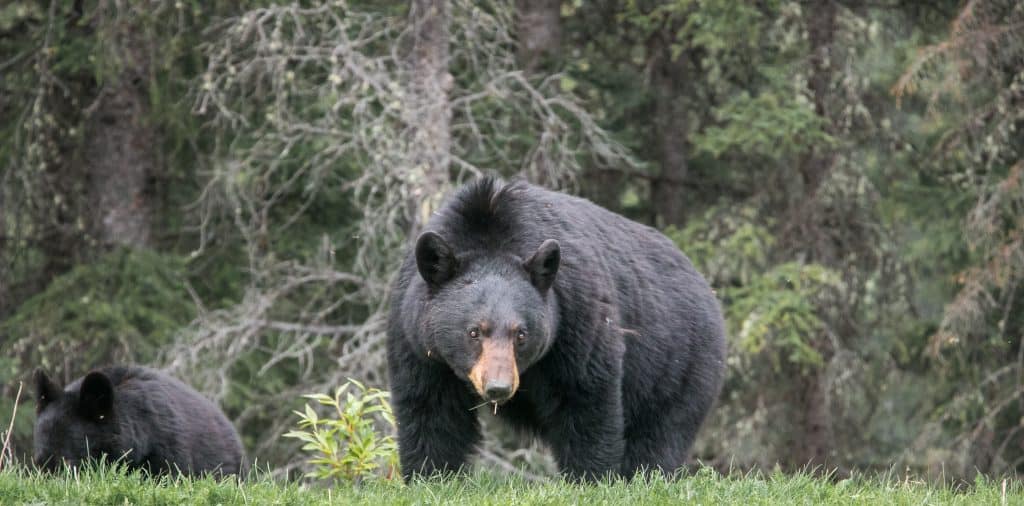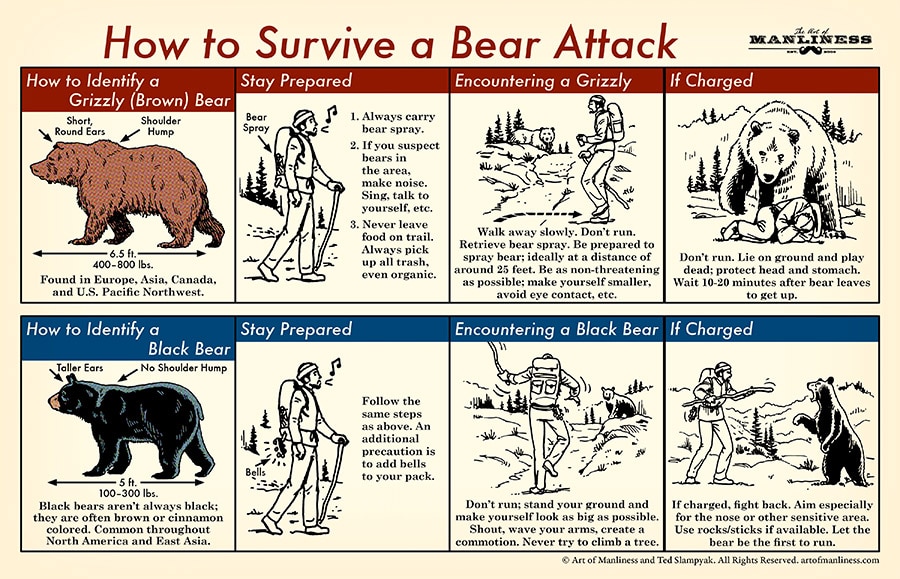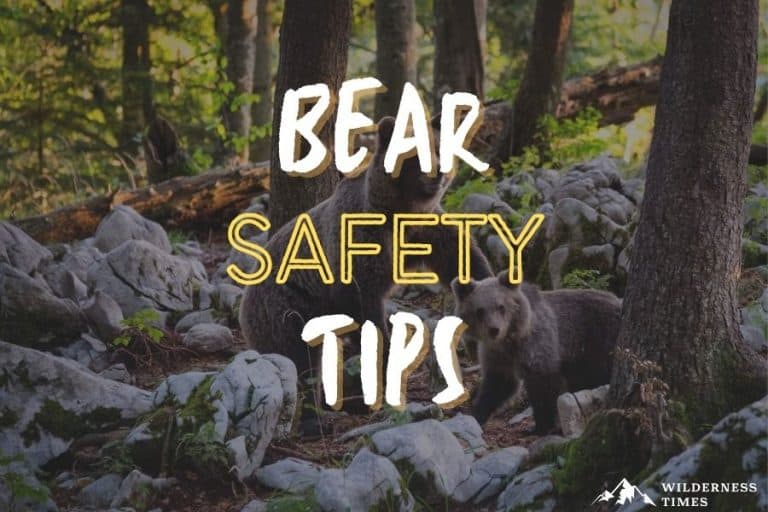Bears. Just their name inspires fear in the heart of us feeble humans.
Go to any campground, and you’ll surely see signs warning you from bears. But, are they really a cause for concern?
Today we’ll face this question head-on and teach you everything you need to know about protecting yourself from bears. We’ll also review some practical self-defense tips that’ll get you out of a pickle.
Don’t worry, by the end of this article you’ll be fully trained to ward off any bold bears you face on the trail.
Table of Contents
ToggleShould You Be Concerned?

Before we begin, I’d like to help you sleep well at night.
Yes, bear attacks do happen.
No, bear attacks are not nearly as frequent as you’d expect.
The numbers are not perfect, but a scientific report from the Nature Research group found that there were only 664 total bear attacks worldwide between the years 2000 and 2015. That means, on average, there are 44 attacks each year.
However, only 14% of those attacks led to death, meaning roughly six people die each year from bear attacks. Remember, that’s worldwide. The overwhelming majority of these attacks happen in Alaska, Europe, and Russia. Very few occur in the continental U.S.

In contrast, it’s estimated that 6,000 people die each year from texting while driving. If that doesn’t scare you, I also found that vending machines kill about 13 people every year. So, next time you’re concerned about bears, remember that those deadly snack machines are twice as hazardous as bears.
Preparation
“Prevention is the best medicine” definitely rings true when it comes to bear attacks.
Instead of fighting off bears, wouldn’t it be much easier to avoid bears to start with? Here are some ways you can prepare yourself or prevent bear attacks, to minimize your risk.
Be Aware Of Your Surroundings
The easiest way to avoid a bear attack is simple – just stay clear of bears (duh). To do that, keep an eye on the perimeter at all times.
I know you probably want to spend your time taking in the sights and sounds, and that’s totally understandable. But you should also be cautious. Take a break from gazing at the mountain tops and occasionally give your surroundings a good once-over.
By being just a tad more attentive to the vicinity, you can prevent bear attacks effortlessly.
Stick To Sunlight
An easy way to prevent bear attacks is to only hike during the day. Sunlight increases your vision, so you can see bears more easily. When you can better see threats, it’s easier to defend yourself from them.
I know we all love to sleep in, but this is an excellent reason to start hiking early in the morning. If you leave your house before the sun comes up, and start hiking around sunrise, that gives you a good 10+ hours (depending on where you are) to enjoy your hiking.
Clean Up After Yourself
Bears are smart. When they smell food, they go after it.
That’s why you should never leave debris on the trail.
This is doubly true if you’re camping in bear country. Leaving your snacks out in the middle of the night is a surefire way for bears to find where you are, and possibly start tapping on your tent.
Make sure you throw out your trash in a receptacle that’s far away from you.
Ideally, use a bear-proof trash bin. Or, bury or hang your waste so bears can’t get to it.
Either way, remember that bears can get pretty creative when they’re hungry:
Travel In Groups
“Two is better than one” rings true for preventing bear attacks. When you’re hiking solo, you’ve only got one pair of eyeballs checking for bears. Bringing a partner or a group with you gives you more eyes on the trail to check for wild critters.
Especially if you’re a beginner hiker new to the trails, it’s a great idea to hike in groups. Not only will you be able to identify bears easier, but you’ll also be able to enjoy some good conversation in the process.
Stay On Designated Paths
I know it’s tempting to “blaze your own trail,” but it might be safer to stay on the beaten path.
Sticking to the trails means you’ll probably run into other hikers. This will keep you safe by giving you strength in numbers.
Also, staying on the trail keeps you from getting lost. No matter where you are, odds are you can stay on the path, and you’ll find your way back to a parking lot or ranger station. It’s much easier to lose your way when you’re in the middle of nowhere compared to staying on the path.
You can also prevent getting lost by familiarizing yourself with a compass.
Pack Bear Spray
If you follow my guidelines, you probably won’t run into a bear. But, you can prepare for the encounter by packing bear spray.
(Don’t worry about learning how to use it effectively, I’ll explain that later)
For now, know that bear spray is affordable (~$30) and lightweight. There’s really no excuse for not bringing a little can of bear spray. This article recommends quality bear sprays that’ll be sure to keep you safe.
Don’t worry about the morals of using bear spray. The active ingredient is concentrated pepper (also known as capsaicin), making bear spray just pepper spray on steroids. It won’t kill the bear, but it will stun them, just like when a human gets pepper-sprayed.
In Case Of Encounter

Now that we’ve gotten the prerequisites out of the way, let’s discuss what to do in case you run into a bear.
If you’re curious, here are the official U.S. National Parks Service recommendations for managing bear attacks. For those short on time, I’ll explain their tips and give my pointers below.
When You First See A Bear
If you see a bear in the distance, stay calm. As long as you’re far away, and they haven’t seen you, you should be able to avoid an encounter.
The best thing to do in this situation is to be quiet and slowly back away. Stay facing the bear (so you can see if it charges you), but start walking away. You can likely diffuse the situation by staying unnoticed.
Do not move towards the bear or try to catch its attention. Above all, keep your cool and don’t do anything crazy.
When A Bear Approaches
If you fell short on hiding from the bear, don’t worry. You can still prevent an altercation by scaring them away.
To do this, make noise. Stand tall, wave your arms, and try to appear as large and intimidating as possible.
Don’t move closer because they could see this as aggression. Don’t run away either, since that could be seen as weakness. Plus, bears are super fast so your chances of outrunning one are slim to none. The best compromise is to stand your ground and exude confidence.
At this point, prepare yourself with a weapon. Bear spray is ideal, but in case you don’t have any, take out a hiking pole, rock, knife, or water bottle that could be used as a weapon. Every outdoors enthusiast’s packing list should include something that could be fashioned into a weapon.
Should You Fight Back?
A common conundrum for campers is if they should attack the bear or play dead.
My take is that you should try to prevent a fight at all costs, using the tips above.
If they do attack you? Only play dead if it’s a brown bear. Brown bears are less vicious than black bears. If they see that you’re incapable of fighting back, they’ll just walk away. Black bears, on the other hand, will continue to attack until you’re subdued. Thus, it’s good to fight back.
With both types of bears, you should try to use bear spray. Best case scenario – you stun them, and you can run away. Worst case? You miss, they don’t know what happened, and continue to attack you. Always use your bear spray.
Bear | What should you do if you see one? |
Kodiak bear | Try to appear larger by waving hands above head, hold your ground, back away carefully. |
Grizzly bear | Avoid eye contact, stand your ground, walk away slowly, curl up into a ball on your side if the bear makes contact. |
Black bear | Back away slowly, act boldly by yelling and throwing something if it approaches. |
Polar bear | Don't run. Try to appear bigger if approached. |
Using Bear Spray
Arm yourself the minute you see a bear. You never know if they’ll charge you, so you want to be ready. Pull your spray out of your bag and remove the safety guard so you can quickly open fire on the bear.
A study by the NPS called “Efficacy of Bear Deterrent Spray In Alaska” found that bear spray wards off bears 90% of the time. Plus, it doesn’t kill the bear, so there’s no moral dilemma involved.
This one-minute video breaks down how to use bear spray effectively:
Caution: Firearms
Some of our more defensive readers might be wondering if they should bring a gun to protect themselves against bears.
There’s a ton of discussion regarding if you should shoot or spray a bear when attacked.
My personal opinion is that you should prioritize bear spray in nine out of ten cases. Most people aren’t correctly trained on firearms, and might not successfully subdue the bear. Even worse, uneducated gun-slingers might misfire and shoot a fellow human. Not good.
Bear spray is an extremely reliable tool, and I recommend its use over guns whole-heartedly.
Conclusion
To wrap things up, bears are big. And scary.
But, that doesn’t mean that you have to be afraid of their presence. Bear attacks are an extremely uncommon occurrence, that will only happen if you spend weeks at a time hiking in places like Alaska or Russia.
However, preparation is easy. All you need to bring is a can of bear spray. This affordable investment can make your hiking trip one hundred times safer. Even better, bear spray is easy-to-use, and anyone can make use of this valuable self-defense tool.
Now, you’re armed with the knowledge to fend off bear attacks. Go forth, hit the trail, and have fun!






